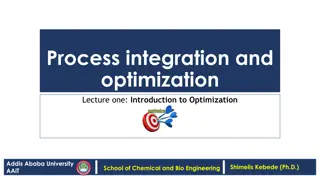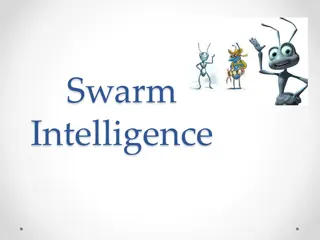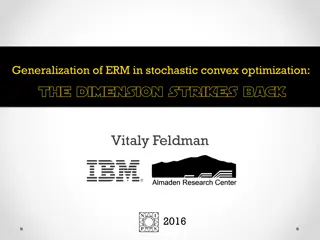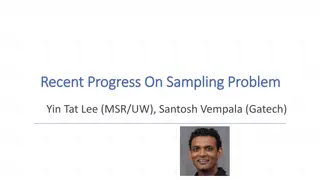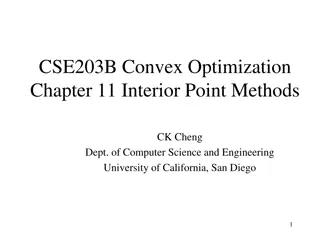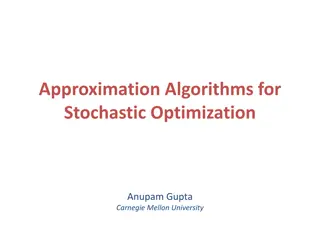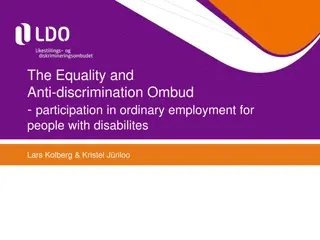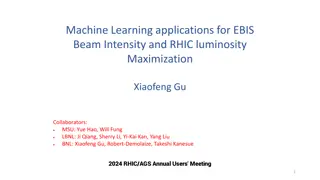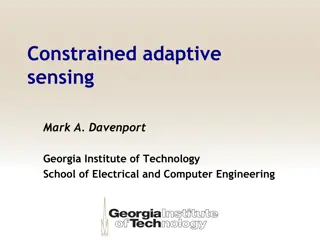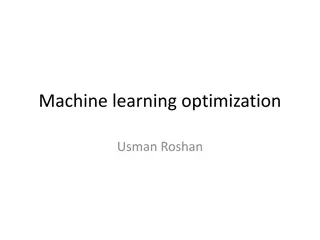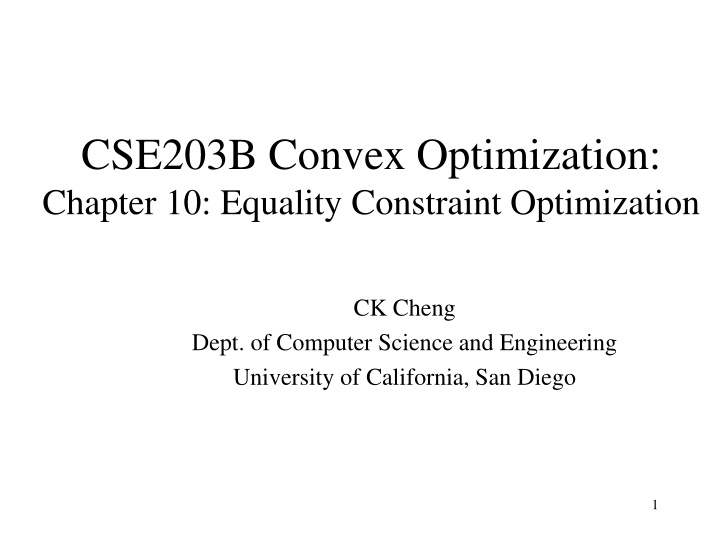
Equality Constrained Optimization Overview
This content delves into Chapter 10 of convex optimization covering equality constrained optimization. It explores various formulations, eliminating equality constraints, dual formulation, KKT conditions, and optimization methods like Newton's method. The formulation examples and theoretical concepts are detailed, providing insights into optimization with linear equality constraints.
Download Presentation

Please find below an Image/Link to download the presentation.
The content on the website is provided AS IS for your information and personal use only. It may not be sold, licensed, or shared on other websites without obtaining consent from the author. If you encounter any issues during the download, it is possible that the publisher has removed the file from their server.
You are allowed to download the files provided on this website for personal or commercial use, subject to the condition that they are used lawfully. All files are the property of their respective owners.
The content on the website is provided AS IS for your information and personal use only. It may not be sold, licensed, or shared on other websites without obtaining consent from the author.
E N D
Presentation Transcript
CSE203B Convex Optimization: Chapter 10: Equality Constraint Optimization CK Cheng Dept. of Computer Science and Engineering University of California, San Diego 1
Chapter 10 Equality Constrained Optimization Introduction Formulations Eliminating Equality Constraints Using Algebraic Replacement Dual Formulation KKT Condition Newton s Method Infeasible Start Newton s Method Summary 2
Introduction Objective Function without Constraints: (Chapter 9) Gradient descent, Newton s methods KKT Linear Equations: Quadratic obj function + linear equality constraints Newton s Method: Twice differentiable obj function + linear equality constraints Interior Point Method: (Chapter 11) Twice differentiable obj function + linear equality + inequality constraints 3
Introduction Formulation 0: Equality Inequality Formulation 1: Algebraic operation to eliminate the equality constraint Formulation 2: Dual formulation Formulation 3: KKT conditions 4
Formulation 0 min ? ? s.t. ?? = ? where ?:?? ?, convex, twice continuously differentiable, ??? ? ?? ?,???? ? = ?,? ? Formula 0 Inequality ??? ?(?) s.t. ?? ? ?? ? 5
Formulation 1 min ? ? s.t. ?? = ? ?:?? ?, convex, twice continuously differentiable, ??? ? ?? ?,???? ? = ?,? ? Formula 1 Algebraic operation to eliminate the equality constraint min?(?) = ? ?? + ?? ? ?? ?,???= ?,???? ? = ? ?,?? = 0 6
Formulation 1 Formula 1: Eliminating equality constraints using algebraic replacement min ?(?) s.t. ?? = ?, Let ??0= ?, nullspace of A is ? ?? ? ?, We can write ? = ?0+ ??, ? ?? ? Thus?(?) = ?(?0+ ??) To minimize ?(?) = ?(?0+ ??) we need ??? ?0+ ?? = ???? ? ?=?0+??= 0. ???? ? = ?,? ? ?.?.?? = 0 Remark: This is equivalent to ?? ? = ???, ? ?? 7
Formulation 1 Example: min?(?1,?2) ?1 ?2 ?2 ?1 = ?, ?1?1+ ?2?2= ? 1? ?2?2, ?1= ?1 ??????? ? ? ?1 ?? ???????????. 1? ?2?2,?2 ? ?1,?2 = ? ?1 1? ?2?2,?2 = 0 derive the optimal Therefore??2? ?1 solution. 1 Remark: The equality constraint elimination, e.g. ?1 operation, may destroy the sparsity of the system. 8
Formulation 2 min ? ? s.t. ?? = ? ?:?? ?, convex, twice continuously differentiable, ??? ? ?? ?,???? ? = ?,? ? Formula 2 Lagrange Dual Function ??? ? ? = ??? ? = ??? ? = ??? ? ? ? + ???? ??? (? ? + ????)] ( ???? ?(?))] ? ? = ??? ??? ? [ ??? + ??? [ ??? ??? ( ??? ? ( ???)) ? ? 9
Formulation 2 Example: ???? ? =1 ?.?. ?? = ?, ? ?++ (1) ??????????: ? ?,? =1 (2) Min ? vs. ?, we have ??(?,?) = ?? + ? + ??? = 0 (3) Thus, ? = ? 1? + ??? (4) Therefore, ? ? = ? ? = ? 1? + ??? ,? = 1 (5) Min ? vs. ?, we have ? ? = ?? 1??? ? + ?? 1? = 0 (6) Thus, ? = ?? 1?? 1? + ?? 1? (7) Therefore, max ? 1 2?? 1? + ???? 1?? 1?? 1? + ? 1 2???? + ??? + ? ? 2???? + ??? + ? + ??(?? ?) 2???? 1??? ??+ ??? 1??? 1 2??? 1? + ? ?(?)= 2??? 1? + ? 10
Formulation 2 ? Ex: min ? ? = ?=1 s.t. ?? = ? 1. ? ?,?,? = ?=1 2. ?(?,?) = min 3. Let min ? log??, ??> 0 ? log?? ???+????-??? ??? + ??? ??? ?=1 ? ?,? =??? ?=1 1 ?1 1 ?? We have min ? 4. Thus, we have min ? Dual m?? ? ? log?? ? ? log?? ?? ?,? ?? 1 ?? = 0, ??= = ? 1 ?? ? ? ?,? = ? log ? ?,??? = ? + log ???? ? ? = ??? + ? + log ????,??? > 0 = ? + ?=1 log?? 11
Formulation 3 min ? ? s.t. ?? = ? ?:?? ?, convex, twice continuously differentiable, ??? ? ?? ?,???? ? = ?,? ? Formula 3 KKT condition ?? ? + ?=1 ??? 0 ?? = 0 ?? ??? KKT condition: ?? ? + ??? = 0 ?? = ? Relation of ? ??? ? :??? = ?? ? ? = ??? 1??? ? ? ????? ?? + ?=1 = 0 ? ?? ?? 0 ??? = 0 12
Formulation 3 Example: ???? ? =1 ?.?. ?? = ?, ? ?+ KKT Conditions 2???? + ??? + ? ? ? ? = ? ? ?? 0 ? ? (1) We know that ?? = ?has feasible solution because ? ?. (2) We have ? + ?equations for ? + ?variables. (3) If ? ? 0 optimal solution. (4) If ? ? 0 Remark: ? ? 0 ? Newton s method for a nonlinear function ?(?). Where ? = ?2? ? ,? = ?? ? ,? = ?(0) ?? is nonsingular, then the problem has a unique ?? is singular then the problem is unbounded. ? ? = ? ?? relate to one iteration of 13
Formulation 3 (3). Nonsingularity i. ? ? ? ? = ii. ?? = 0,? 0 ???? > 0 iii. ???? > 0 for ? ?? ? ?,? ? = ?(?) iv. ? + ???? > 0 for some ? 0 Property ii: If ? ? 0 so that ? ?? ? 0 Therefore, we have ? ?? ? 0 is singular, we can find ? ?? ? ? ?=0 0 ?? = 0 ? ?= ???? + 2???? = ???? = 0 ?? ?? 14
Formulation 3 ? ?=0 ?? 0 Proof (4): Let ? ?? = ???, ?? = 0 0 ? Given ??0= ?, we have ? ?0+ ?? =1 =1 2?0 1. 2. ????0= ?0 Thus, ? ?0+ ?? =1 Therefore, when ??? + ??? 0,? ? is unbounded 2?0+ ???? ?0+ ?? + ???0+ ?? + ? ???0+ ?????0+1 2?2???? =1 ??? = ?0 2?0 2?2???? + ???0+ ???? + ? 2?2?? ??? = 0 ? ??? = ????0= ??? ???0+ ? ??? + ??? + ???0+ ? 1 15
Newtons Method min?(?) ?.?.?? = ? (1) Taylor s expansion to approximate ?(?) ? ? + ? ? ? + ?? ?? ? +1 ?? = ?, ? ? = 0 (? ? + ? = ?) (2) KKT conditions for the quadratic obj. ?2?(?) ?? ? 0 ? (3) From (2), ?2? ? ? + ??? = ?? ? We have ?? ?? ? = ?2? ? ? + ???? ? = ???2? ? ? ??? ? = ???2? ? ? Thus ? ? + ?? ?? ? +1 = ? ? 1 The amount that the obj. drops 2 ???2? ? ? = ??(?) ? 0 2 ???2? ? ? 2 ???2? ? ? 16
Newtons Method ??????? ?. Given ? ?,?? = ?,? > 0 Repeat 1. Solve ?? to find ? & ?2= ???2? ? ? 2. Quit if ?2 2 ? 3. Line Search ? 4. Update ? ? + ? ? 17
Newtons Method: Affine Invariant min?(?) ?? = ? Theorem: Newton s step is invariant to affine transform. Proof: Let ? = ??,? ???,? ? = ? ?? = ?(?) For the problem min ?(?) ??? = ? 2 ? ? = ?? 2? ?? ? 1. We have ?? ?(?)= ?? ??(??), ? 2. For ??? at ?, we have the Newton step, ???2? ? ? ?? which is equivalent to ?2?(?) ? ???? 0 = ????(??) ??? ? , 0 ?? 0 = ??(?) ? ? 0 18
Newtons Method for Reduced Problem min?(?) = ? ?? + ?? ? ?? ?,???= ?,???? ? = ? ?,?? = 0 p? ?(? ?) We have ??? ?? + ?? = ????? ?? + ?? ??2? ?? + ?? = ????2? ?? + ??? Thus, the reduced problem has Newton iteration derivation, ? = ??2? 1??? = ????2?? 1????? ? = ? ? = ? ???2? ? ? 1????(?) Theorem: For the reduced operation,the derived ?,? are the same solution as the original NE process. Proof: Let ? = ? ?,? = ??? 1?(?? ? + ?2? ? ?) We can show that the original NE equations hold, i.e. ?2? ? ? + ?? ? + ??? = 0 & ? ? = 0 Show this by Taylor s expansion 19
Newtons Method for Reduced Problem Proof: 1. For the first equation, we multiply the left expression from the left, i.e. ?(? ?)? ?(??) ???2? ? ? + ????? + ????(?) ??2? ? ? + ???? + ???(?) (1) ???2? ? ? ???2? ? ? 1???? ? + ???? ? + ????? = 0 (2) ??2? ? ? + ??? ??? 1? ?? ? + ?2? ? ? ??? ? = 0 Since ?(? ?)? ?(??) ?2? ? ? + ??? + ?? ? =0 2. For the second equation,we have? ? = ?? ? = 0, since ?? = 0 by construction. ? ?2? ? ? + ??? + ?? ? = 0 (1) 0 (2) = + ? is a full ranked matrix, we can conclude that 20
Infeasible Start Newtons Method The search of the feasible start point, ?2?(?) ? We can write in incremental derivation, ?2?(?) ?? ? 0 ?? 0 ??(?) ?? ? ? ? = = ?? ? + ??? ?? ? ????? ???? ? ? 21
Newton Method: Infeasible Start ??????? ?. Given ? ?,?, tolerance ? > 0,? 0,1 Repeat 1. Compute primal and dual Newton steps ???, ??? 2. Line search on ? ?,? ? 1 while ? ? + ? ???,? + ? ??? ? ??. 3. Update ? ? + ? ???,? ? + ? ??? Until ?? = ? and ? ?,? 2 ? 2,? 0,1 . 2= (??????,? ,????(?,?) 2 2 >(1-??) ? ?,? 2 22
Summary KKT Linear Equations: Quadratic objective function + linear equality constraints Newton s Method: Twice differentiable obj function + linear equality constraints Interior Point Method: Twice differentiable obj function + linear equality + inequality constraints 23

